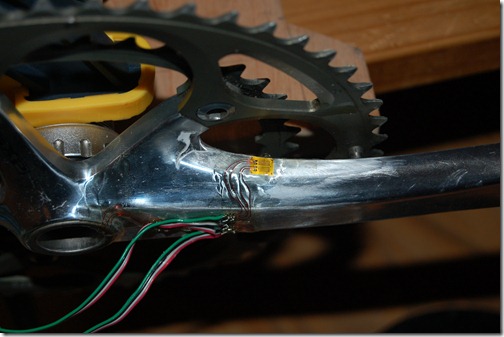Power meters are essentially a combination of torque and cadence. Torque (N-M) times angular velocity (rad/s) = power (watts). Cyclists generally know about their cadence through a magnet on the crank and a pickup on the bike measuring the time and calculating RPM.
However, what about torque? This is a more painful proposition to measure and as such several companies have come out with devices to do this. The first and “golden” standard is SRM. I honestly don’t see any engineering superiority but they have the experience of being the first. SRM has four small cantilever beams as a crank spider (instead of the normal 5) measuring strain at each beam and converting it to torque between the BB and the chain ring. They have an outer ring which provides sufficient stiffness that changing chain rings shouldn’t require calibration.
Quarq on the other hand doesn’t have this stiffening ring. What does that mean? Well, each set of chain rings have a different stiffness – which is how much they deflect in a rotational direction for a given load. Since the torque will always be transferred mostly by the spider arm nearest the top off the chain ring, how stiff the chain ring is affects how much the next arms are transferring. This is why they have calibration tables or have to be sent back for calibration.
Powertap is a simple torque tube. Simple, reliable, and generally lower cost.
Coming soon is Garmin’s vector product, but it’s been delayed several times. It’s claim to fame is left and right power readings – as a result they updated the Garmin EDGE 500 to show this.
What is my prototype then?
Left and Right power, but measure them in the crank. How. Well Prototype V2 shown below has strain gauges at the crank arms measuring torque directly. This allows measuring the left and right legs individually. Prototype V3 which be slightly different.
V2 works, but has some issues. I’ll be posting a video in the next couple of weeks hopefully. It’s a bit of a pain as the left arm has to be soldered on after the crank is installed as wires run through the BB hollow shaft. This will NOT be the case for V3 as the left leg will be measured as torque through this shaft and not at the arm. This idea was actually presented to Quarq in a job application. Hey look, public reveal thus non-patentable!

No comments:
Post a Comment